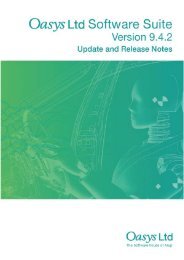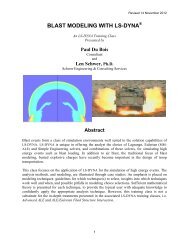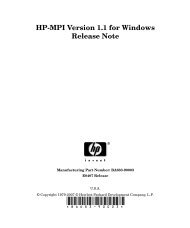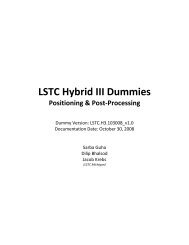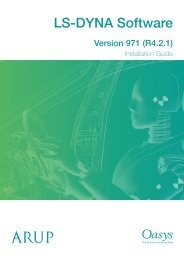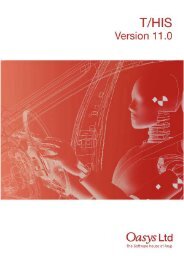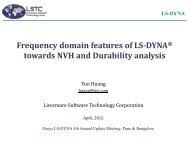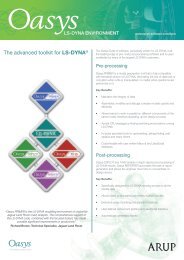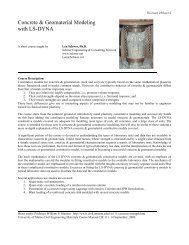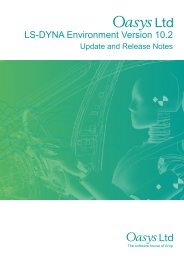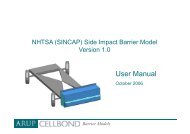Oasys LS-DYNA Environment 8.1 VOLUME 3 ... - Oasys Software
Oasys LS-DYNA Environment 8.1 VOLUME 3 ... - Oasys Software
Oasys LS-DYNA Environment 8.1 VOLUME 3 ... - Oasys Software
Create successful ePaper yourself
Turn your PDF publications into a flip-book with our unique Google optimized e-Paper software.
<strong>Oasys</strong> <strong>LS</strong>-<strong>DYNA</strong> <strong>Environment</strong>: User Guide (Version <strong>8.1</strong>)<br />
! Node coordinates<br />
! Shell, solid, beam or thick shell elements unless a whole PART is deleted.<br />
! Element topology<br />
! Element part references<br />
! Element formulations<br />
! Material types<br />
! Anything else which affects storage of element stresses etc, such as element local axis<br />
systems.<br />
! Seatbelt retractor, slipring, pretensioner and sensor properties<br />
! Airbag parameters<br />
! Rigid body properties (centre of mass, mass inertia tensor)<br />
! Initial velocities<br />
! Rigid body extra nodes, merges and anything else that determines which nodes are part<br />
of which rigid body.<br />
Other features can in theory be changed, but are likely to cause sudden jumps in stresses when<br />
the restart occurs; the jumps can in some situations be so violent that the analysis crashes. Such<br />
features include:<br />
! Material properties (including properties for spring and belt elements)<br />
! Section properties<br />
! Joint stiffness and connectivity<br />
The following things can be changed:<br />
! Anything to do with contacts - even introduction of new contact surfaces. All contact<br />
parameters can be changed.<br />
! Restraints, constraints and other boundary conditions.<br />
! Load curves<br />
! Control parameters (e.g termination time) and output intervals<br />
It is also possible to add new nodes, elements, parts, etc which were absent from the original<br />
analysis, and to omit whole parts which were present in the original analysis. The new parts will<br />
be undeformed at the beginning of the restart analysis, in this case further input is required after<br />
*STRESS_INITIALISATION. This can be used for multi stage sheet metal pressing<br />
simulations: the tool models can be replaced at the end of each stage.<br />
There are some bugs in <strong>LS</strong>-<strong>DYNA</strong> affecting full-deck restarts:<br />
! Spotwelds and tie-break contacts (types 8 & 9) which had failed in the original analysis<br />
became stuck together again in the restart.<br />
! The previous history of non-linear contacts (types 9, 20, 21) is lost. The force developed<br />
on any contacts which was unloading at the time of the restart suddenly jumps to the<br />
force registered on the loading curve at the current displacement.<br />
Page 3.6



